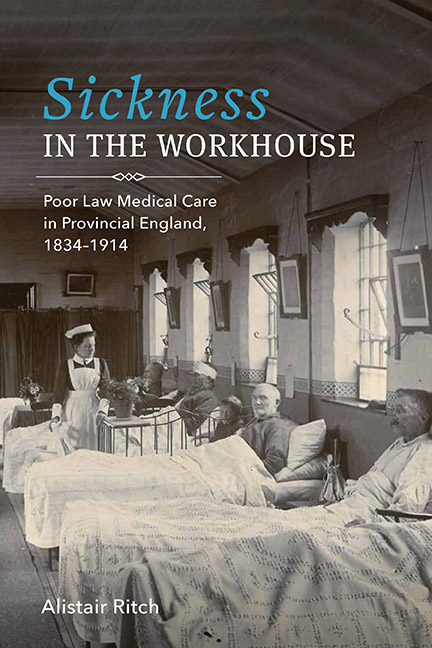Book contents
- Frontmatter
- Dedication
- Contents
- List of Tables
- Acknowledgments
- Introduction: Pauperism and Sickness
- 1 From Acute Illness to Chronic Disability
- 2 Segregating Fever Patients
- 3 Controlling Disorderly Behavior
- 4 Day-to-day Doctoring
- 5 Medical Therapies
- 6 Poor Law Nursing
- 7 “Every Care and Kindness”: The Standard of Workhouse Medicine
- Appendix A Prevalence of Selected Infectious Diseases in Birmingham Workhouse on the Last Day of the First Week of Each Quarter for the Years 1877–80 and 1894–1911
- Appendix B Medical Relief in Birmingham Workhouse for Selected Weeks, 1851–56
- Appendix C List of Drugs Kept in the Wards of Birmingham Infirmary in 1896
- Appendix D Pauperism Rates and Institutionalization Rates for Birmingham Parish, Wolverhampton Union, and England and Wales, 1840–1911
- Notes
- Bibliography
- Index
3 - Controlling Disorderly Behavior
Published online by Cambridge University Press: 21 March 2020
- Frontmatter
- Dedication
- Contents
- List of Tables
- Acknowledgments
- Introduction: Pauperism and Sickness
- 1 From Acute Illness to Chronic Disability
- 2 Segregating Fever Patients
- 3 Controlling Disorderly Behavior
- 4 Day-to-day Doctoring
- 5 Medical Therapies
- 6 Poor Law Nursing
- 7 “Every Care and Kindness”: The Standard of Workhouse Medicine
- Appendix A Prevalence of Selected Infectious Diseases in Birmingham Workhouse on the Last Day of the First Week of Each Quarter for the Years 1877–80 and 1894–1911
- Appendix B Medical Relief in Birmingham Workhouse for Selected Weeks, 1851–56
- Appendix C List of Drugs Kept in the Wards of Birmingham Infirmary in 1896
- Appendix D Pauperism Rates and Institutionalization Rates for Birmingham Parish, Wolverhampton Union, and England and Wales, 1840–1911
- Notes
- Bibliography
- Index
Summary
This chapter is primarily concerned with certain groups of patients whose behavior was challenging or difficult to control within the institution. For those with mental illness or epilepsy, it was beyond their control. Patients who contracted venereal disease did so as a direct result of their actions, but they were prone to misbehave when residing in the workhouse. However, mentally ill patients were not completely absolved of blame for their condition because of the links between insanity and bodily disturbance; for example, one strongly held theory by many doctors was that it was caused by masturbation and other acts that were regarded as immoral. A number of questions will be addressed in relation to these groups of paupers and the workhouses in the two towns. As the treatment of mental illness in asylums changed throughout the nineteenth century from the widespread use of mechanical restraint to moral management, what effect did this have on the treatment of lunatics in workhouses? With their lower staff-to-patient ratios than asylums, how did workhouses cope with behavioral disturbances? To what extent were physical treatments for mental disorders also used for punishing any type of misdemeanor and how frequently were workhouse staff at risk of sustaining injury from disturbed patients? Patients with epilepsy posed a particular problem for staff as they were at risk of injuring themselves during a seizure. How frequently were they subjected to forms of mechanical restraint after these were no longer allowed for mental illness? How disturbing was the frequency of epileptic fits to both sufferers and other inmates? What implications did the development of epileptic colonies in the early twentieth century have for epileptic patients in the workhouse? A significant proportion of inmates with mental disability suffered from epilepsy, and as a result lunatics and epileptics were usually accommodated in the same wards in the workhouse. So it is not always possible to identify them discretely, although attempts will be made to do so as much as is possible. Workhouse provision and dedicated facilities for patients with venereal disease will be covered in respect of the scarcity of specialist care. The types of treatment they received will be analyzed and the extent to which they were subject to discrimination on moral grounds will be explored.
- Type
- Chapter
- Information
- Sickness in the WorkhousePoor Law Medical Care in Provincial England, 1834–1914, pp. 94 - 125Publisher: Boydell & BrewerPrint publication year: 2019



